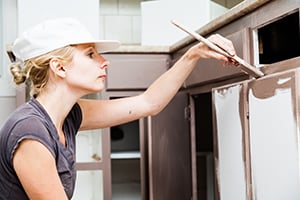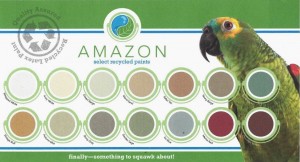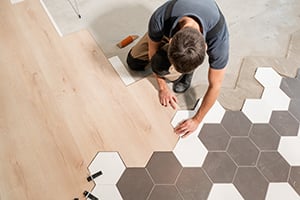DIY Kitchen Remodel: A Step-By-Step Guide
-
Table of Contents
- Cabinets vs. Appliances: Where Do You Start?
- Should You Repair or Replace Kitchen Cabinetry
- Tips on Shopping for Kitchen Appliances
- Tips on Shopping for Used Kitchen Cabinets
- Painting Your Kitchen
- Installing New Kitchen Flooring
- Where to Shop for Your Kitchen Remodel
- What to do with You Leftover Remodel Materials
FREE DOWNLOAD
Don’t have time to read the whole guide?
How about a copy to-go? Fill out this form to get your own copy of our Step-by-Step Guide to Remodeling Your Kitchen.
Want to give your kitchen a fresh upgrade? You probably have many questions running through your head. What should you install first? The cabinets or the appliances? Do you need to replace the flooring?
In this guide, we answer those questions and more—and hopefully give you a head start on remodeling the most important room in your house: the kitchen.
Cabinets vs. Appliances: Where Do You Start?
There are compelling reasons for each choice, but the decision should involve much more than just personal preference. If your goal is to keep your costs—and your headaches—under control, you'll want to carefully weigh another important decision at the very beginning of your kitchen project: your layout.
 Refrigerators and sinks require water lines, while ovens or ranges require gas lines and/or electricity. The location of these lines will determine where your appliances must be installed or remain, unless you decide to reroute those lines as well. Most homeowners start with finding appliances first, then build around those.
Refrigerators and sinks require water lines, while ovens or ranges require gas lines and/or electricity. The location of these lines will determine where your appliances must be installed or remain, unless you decide to reroute those lines as well. Most homeowners start with finding appliances first, then build around those.
Barring the issue of water, gas, and electricity locations, which do you install first, kitchen cabinets or appliances? It’s simply a choice of preference:
-
Choose appliances first if you have a specific type/size of appliance in mind
-
Choose cabinets first if you plan to use a standard appliance size and you care more about storage in your kitchen
Get more details in our blog on Kitchen Cabinets vs. Appliances: Which Do You Replace First? Plus, here are helpful tips on installing kitchen cabinets yourself.
Should You Repair or Replace Cabinetry?
 If you’re remodeling your kitchen, you might be thinking you want to gut the whole room and start from scratch. That’s one way to go, but have you considered cleaning up your cabinets rather than replacing them?
If you’re remodeling your kitchen, you might be thinking you want to gut the whole room and start from scratch. That’s one way to go, but have you considered cleaning up your cabinets rather than replacing them?
Nowadays, white or colorful cabinets are all the rage. And thankfully, painting cabinets isn’t too difficult! This blog covers ways to dress up cabinet doors. Here are some of the key takeaways:
- Restaining cabinets requires a lot of sanding to get rid of the old stain. It can be worth it, but be ready to put in the extra time.
- Painting with chalk paint or even spray paint can give old cabinets new life fast.
- If you want to try something fancier, you can add stained glass tiles to some or all of your cabinets.
Tips on Shopping for Appliances
 One of the most essential parts of remodeling a kitchen is upgrading your kitchen technology. Whether you’re getting a more efficient refrigerator or you’re looking to change from an electric stove to gas, there are some pretty big considerations to make during the remodeling process.
One of the most essential parts of remodeling a kitchen is upgrading your kitchen technology. Whether you’re getting a more efficient refrigerator or you’re looking to change from an electric stove to gas, there are some pretty big considerations to make during the remodeling process.
Appliance Brand. Every brand has a certain reputation associated with it. Make sure you do your research before heading to a store so you know what brands best fit your needs.
Appliance Sizes. If you’re installing your cabinetry first or just updating your existing set, you’ll need to fit your appliances into predetermined spaces. Make sure you narrow your search to just the appliances that will fit in your kitchen!
Buying Used vs. New Appliances. Many people only consider buying new appliances when upgrading. However, most appliances have an average lifespan of 10 to 20 years. Dishwashers, microwaves, and refrigerators average around 10 years while many other appliances can last up to 20 years. That means you can save big on kitchen appliances and still get a lot of life out of them! Learn more in our blog about shopping for used appliances.
Tips on Shopping for Cabinets
When shopping for cabinets, you’ll need to think about their size, functionality, and quality. If you’re looking to buy new cabinets, you can typically find a store that will adapt the cabinetry to your specific kitchen.
However, as a DIYer, if you’re trying to save money and do it on your own, you may want to consider used cabinets. Here are some tips for shopping for used kitchen cabinets:
Pay Close Attention to Quality. Are the cabinets made out of particle board or plywood? Particle board is engineered wood made from wood chips or sawdust, and it’s poorer quality than real wood. Are the drawers stapled or do they have a dovetail joint? A dovetail joint will be much sturdier over time, so if your kitchen gets a lot of use, go for the dovetail.
Don’t Worry About the Color. When shopping for used cabinetry, try to find quality cabinets that will fit your kitchen. Paint or stain color is something you can change on your own, so don’t let it influence your final decision.
Pick Your Own Hardware. In our Kitchen Remodel 101 blog, we recommend the cheap and easy DIY project of changing out hardware such as new handles and hinges.
Revitalizing used kitchen cabinets is one of the most rewarding DIY projects you can undertake—saving you thousands of dollars while allowing you to achieve a look that is unique to you and you alone.
Painting Your Kitchen
 If you’re gutting your kitchen and replacing all the cabinetry and appliances, the best time to paint is when the walls are clear so you have plenty of space. However, if you’re just cleaning up your cabinets or replacing your appliances, you’ll have to work around your current layout. Make sure you have plenty of painter’s tape, plastic sheeting, and drop cloths to keep your flooring, countertops, and cabinetry free of paint!
If you’re gutting your kitchen and replacing all the cabinetry and appliances, the best time to paint is when the walls are clear so you have plenty of space. However, if you’re just cleaning up your cabinets or replacing your appliances, you’ll have to work around your current layout. Make sure you have plenty of painter’s tape, plastic sheeting, and drop cloths to keep your flooring, countertops, and cabinetry free of paint!
Your kitchen may have a popcorn ceiling you want to update. Take special care because homes built before 1980 sometimes have asbestos in their popcorn ceilings. It is possible to paint popcorn ceilings so you don’t have to scrape them.
Paint isn’t cheap, especially if you need a lot of it! So try buying some affordable interior paint from ReStore. We partner with a company called Amazon Paint, a manufacturer of high-quality, recycled paint. By using Amazon Paint, you’re saving money and making a difference by keeping paint out of a landfill! And, once again, the money from your purchase goes towards the Twin Cities Habitat for Humanity mission.
Installing New Kitchen Flooring
There are two big questions with kitchen flooring: what type of flooring is best for a kitchen and when should I install it?
 What type of flooring is best for a kitchen? For most families, the kitchen gets more foot traffic and spills than almost anywhere else in the house. That means a kitchen floor needs to be durable and waterproof, so carpet is ruled out. Also, most real hardwood is often not waterproof, so that’s something to avoid for a kitchen floor. Typically, you’ll want to stick with tile of some sort, whether it’s ceramic, stone, or “Luxury Vinyl.”
What type of flooring is best for a kitchen? For most families, the kitchen gets more foot traffic and spills than almost anywhere else in the house. That means a kitchen floor needs to be durable and waterproof, so carpet is ruled out. Also, most real hardwood is often not waterproof, so that’s something to avoid for a kitchen floor. Typically, you’ll want to stick with tile of some sort, whether it’s ceramic, stone, or “Luxury Vinyl.”
Luxury Vinyl Tile (or LVT) comes in many options, from faux wood planks to faux ceramic, stone, or other tiles. It’s often easier to install than ceramic, with glue-down, click lock, or peel-and-stick options. On the other hand, ceramic tile is higher quality and typically more durable than LVT, but it also risks cracking over time and takes a little more time and expertise to install. Learn more about tile flooring in our article, What to Look for When Shopping for Tile Flooring.
When is the best time to install kitchen flooring? It’s no surprise that once your cabinets are installed, it will be more complicated to install flooring. Naturally, you’ll have to cut around your cabinetry or lift up your cabinets to install underneath them. Therefore, if at all possible, try to install your flooring before cabinets and appliances. However, it’s certainly doable to install flooring around your cabinet layout. It just requires some more creative angles and cuts.
Where to Shop for Your Kitchen Remodel
There are many cabinetry, flooring, and general hardware stores in the Twin Cities area. Some, like Home Depot, Menards, or Lowe’s, offer all three solutions in one neat package. Others may be smaller, family-owned, or more niche solutions.
However, they all have one thing in common: Their inventory is typically at full Manufacturer Suggested Retail Price (MSRP). It also may include costs such as expert installation and/or shipping to your house.
With the MSRP and all those bells and whistles, you may end up spending much more than you initially intended. But you’re reading this guide because you’re a DIYer! You’re looking to save money and learn a little something in the process. There’s really only one place in the Twin Cities best suited for that goal: Twin Cities Habitat for Humanity ReStore.
 What is Habitat for Humanity ReStore?
What is Habitat for Humanity ReStore?
Much like other home improvement outlets, ReStore sells just about anything for your house: building materials, tile, carpet, sinks, furniture, flooring, lighting, paint, cabinetry, appliances, and so much more. However, everything on our sales floor has been donated, which means you get it for a fraction of the price of competing retailers! It’s a great place to start a budget-friendly kitchen remodel.
Two of our shoppers, Julie and Gayle, remodeled their homes using products bought at ReStore.
You can also make your remodel project environmentally friendly by shopping at ReStore! Since every product you buy at ReStore was donated, your purchases help to keep that inventory out of a landfill. Plus, your support helps people in your local community access safe, stable housing.
What to Do With Your Leftover Remodel Materials
 By this point, you’ve successfully remodeled your kitchen. Congratulations! But now you likely have leftover materials such as extra cabinets, old appliances, tools you won’t need anymore, extra cans of paint...—you name it, you've got it. So, what are you going to do with it all? Here are some suggestions:
By this point, you’ve successfully remodeled your kitchen. Congratulations! But now you likely have leftover materials such as extra cabinets, old appliances, tools you won’t need anymore, extra cans of paint...—you name it, you've got it. So, what are you going to do with it all? Here are some suggestions:
Sell it! This is a great way to make back some of the money you spent remodeling your kitchen. Use sites like Facebook Marketplace, Craigslist, eBay, or just have a good old fashioned yard sale to clear out the materials. The benefit of selling is that you’re able to put old products to good use while making some extra money! The downside is it might take a while to sell a refrigerator or cabinets—not to mention the complications of transport. If you need to get rid of your remodel materials quickly, selling them might not be the best option.
Reuse it. Have old kitchen cabinets you don’t want in the house anymore? Install them in your garage for extra storage space! Do you have extra boxes of tile taking up space? Make a mosaic table or lay them in your garden outside! There are many ways you can creatively reuse extra building materials.
Donate it. If you don't want to use the leftover materials yourself or recycle them, think about donating them to ReStore. You may be surprised to find out how much of a tax break you can get from donating building materials. Our outlets accept donations of gently used appliances, housewares, and furniture as well as building materials like paint, lumber, tiles, and more. Check out our donations guidelines to learn more.
A kitchen remodel is a big project, but it’s one of the most valuable projects you can tackle in your home. We hope this guide will help you on your DIY journey, and if you ever have any questions, stop by one of our two ReStore locations in the Twin Cities!

